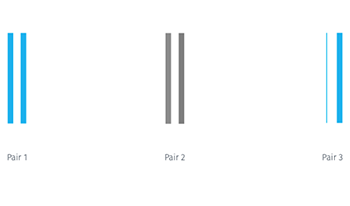
Imaging is enabled by the limitations of the human visual system, which is blind to certain physical differences. The trichromacy of human vision, e.g., allows for very different materials to be combined in a way that results in the same signals triggered by the eye’s cones. As a result a print can elicit the same response as a display, or a projection can yield colors like those in a painting. The limits of spatial acuity too allow for discrete patterns, e.g., those resulting from halftoning, to appear continuous. This paper turns its attention to the limits of color difference perception in stimuli with a very small subtense, such as thin lines or fine features of 3D objects. A first set of psychophysical data, obtained in an on-line visual experiment, indicates a dramatic relaxation of perceptibility thresholds when comparing very thin with thicker lines. The second half of the paper then presents printer imaging pipeline strategies that take advantage of these experimental findings to successfully render fine lines while taking advantage of the more limited sensitivity with which their specific colors are perceived.
Ján Morovič, Peter Morovič, "The Perceptibility of Color Differences between Thin Lines and its Application to Printing Imaging Pipelines" in Color and Imaging Conference, 2022, pp 36 - 41, https://doi.org/10.2352/CIC.2022.30.1.08
 Find this author on Google Scholar
Find this author on Google Scholar Find this author on PubMed
Find this author on PubMed